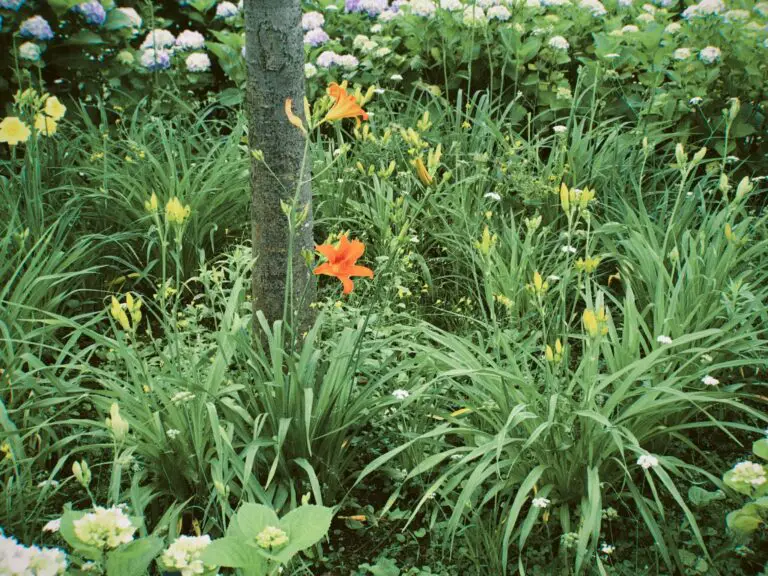Understanding Sedum Spread
Have you ever witnessed the beauty of Sedum, only to realize it’s taking over your garden like a green blanket laying claim over your other plant pals? Sedums are not just about their pretty faces; they’re also known for their wandering ways. Many gardeners often ponder why their sedum plants sometimes exhibit an itchy foot, spreading farther than expected. Let’s unpack the mystery behind this behavior, delve into the world of various Sedum species, and explore how each of their spreading tendencies could affect your garden!
First off, Sedum plants, also known colloquially as ‘Stonecrop,’ are real survivors. These succulent perennials have a remarkable ability to multiply, conquering territories far and wide. But why do they spread so energetically? It’s all in their nature! Sedums are hardwired to survive in tough conditions, and their spreading is a testament to their resilience. Whether it’s an enthusiastic Sedum spurium cascading over rock walls or a robust Sedum telephium stretching out its roots, each variety has its signature move in the sedum spread dance.
Take, for example, the travels of ‘Autumn Joy.’ This popular sedum variety not only brings joy with its autumnal hues but also knows how to throw a garden party by inviting itself over to neighboring plots. The plant’s thick, mat-forming growth habit makes it a formidable ground cover that can out-compete more timid flora. Meanwhile, creeping types like Sedum acre know no bounds as they happily inch their way across garden beds and even sneak into crevices in search of new territories.
To illustrate, imagine the Sedum reflexum, also charmingly known as ‘Blue Spruce Stonecrop,’ its blue-green needle-like leaves spreading around with a sort of botanical wanderlust. This traveler doesn’t need a suitcase, just a bit of a breezy day or a friendly bird to carry its pieces to new lands. Just check out this  shot of Sedum reflexum in action!
shot of Sedum reflexum in action!
A closer look at your garden may reveal a tale of plant conquest, with sedum at the helm. Yet, fear not – understanding which sedum you’re dealing with is the first step in navigating their expansionist ambitions. For those already facing a sedum takeover, trimming techniques might just be your new best friend. For more on this, explore our article on seasonal sedum care tips where we discuss the art of keeping these robust beauties in check.
So there you have it, fellow green thumbs. Sedums are dynamic, resilient, and can sometimes be akin to that one guest who loves your party so much they invite themselves over the following weekend, and the next… But armed with knowledge and a pair of pruning shears, you can enjoy the sedum fiesta on your own terms. Just remember to occasionally reel in those nomadic tendencies!
Essential Tools for Sedum Management
Are you ready to become the master of your sedum landscape? Well, strap on your gardening gloves and listen up, because I’m about to walk you through your must-have toolkit for keeping those eager sedum spreaders in check!
First off, grab yourself a pair of sharp shears. Imagine you’re a sculptor and your sedum is the marble—those shears are going to chisel out the masterpiece that is your perfectly pruned garden. Not just any shears, though; you need a pair that can give you clean cuts without making a mess of the plants or your hands.

Next up is the trusty spade. Picture this: you’re trying to plant new additions or, perhaps, that sneaky sedum has shot up where it isn’t welcome. That’s where your good ol’ spade comes into play, your loyal sidekick for when it’s time to dig in and get your hands dirty.
Now, let’s talk about some serious containment with root barriers. These unsung heroes work behind the scenes, keeping your sedum’s adventurous roots from turning your garden path into a jungle. They’re the invisible fences that give you control over where and how much your sedum will grow.
Of course, we can’t forget about safety. Working in the garden isn’t all sunshine and rainbows—sharp tools and heavy lifting come with their risks. That’s why I’ll share a little sage advice: always check out some trustworthy garden tool safety tips before you dive into your gardening escapades.
With these essential tools in hand, you’re well on your way to reigning in that sedum and turning your garden into the envy of the neighborhood. And that’s not just a figurative statement; with these tools, you’re going to shape, redirect, and control sedum growth like a pro. Happy gardening!
Cultural Practices for Controlling Sedum
Are you watching your sedum plants take over your garden like little green bandits on a spree? Fear not! A few cultural practices, cleverly applied, can put a stop to their runaway conquest. Let’s chat about how you can keep those sedums in check, so your garden remains a harmonious kingdom of varied flora.
First and foremost, proper planting is akin to setting the stage for a play that’s meant to captivate, not run amok. Plant your sedum with ample space around. Think of it as giving each plant its own spotlight. Crowded sedums tend to become the garden’s bullies, squashing the potential for other plant buddies to flourish. Aim for the sweet spot in spacing – not too close, yet not so far that your sedums start yearning for neighboring turf.
When it comes to suitable companions, consider this real-life example: Imagine a playground where the only equipment is a slide. Soon, there’s pushing and shoving to reach the top. But when there are swings, climbing frames, and sandboxes too, everyone plays happily. Apply this to your garden by introducing plants that can stand their ground beside your assertive sedums. Who knows, a feisty marigold or a doughty daisy might just teach your sedums some manners.
Now, here’s a visual for you! Consider our guide on finding the perfect sedum spot in your garden – it’s quite the revelation for aspiring green thumbs eager to foster a sedum sanctuary without letting the plants go wild.
Let’s also talk runner control. Sedums send out runners faster than a cheetah on a caffeine buzz. Snip them early, and you’re the garden sheriff keeping the peace. Those runners can be repurposed, introduced to new territories, like pots or less crowded garden spots, where they can grow without becoming invaders.
Finally, think defense. Bordering your sedum patch with a sturdy barrier is like casting a garden spell – a line they shall not cross. Whether it’s a row of rocks or a charming little fence, this can be both an attractive garden feature and a solid line of defense against the sedum spread.

Ultimately, controlling sedum isn’t about stifling their spirit; it’s about directing their growth in a way that benefits your entire garden’s biodiversity. With the right practices and a vigilant eye, you become the masterful garden conductor, orchestrating a symphony of plant life that respects boundaries and adds to the overall beauty of your outdoor haven.
Physical Barriers and Borders
It’s a tale as old as time: you plant a little sedum, expecting a modest flourish of greenery, and before you know it, your garden’s turned into a full-blown sedum runaway. If you’ve been wondering how to put the brakes on your proliferating plants, pay attention to this lesson in containment—it’s a game-changer.
Let’s dig into the world of physical barriers. Imagine an underground fortress, but instead of protecting a treasure, it keeps your spirited sedum neatly within its assigned quarters. That’s exactly what underground root barriers do. Installing them is like setting a boundary line that says, “This far, no further!”—keeping your garden well-organized and your sedum from making a break for it.
Choosing the Right Material
Choosing the right edging material can feel like picking out accessories for your favorite outfit; it has to be functional yet stylish. Whether it be plastic, metal, or concrete borders, you want something that compliments your garden’s aesthetic while being sturdy enough to stand up to the invasive tendencies of your sedum. Go for edges deep enough to discourage even the most adventurous of roots and strong enough to withstand the elements—they’re the border patrol of your garden realms.
And it’s not just about holding back the green tide! Edging materials serve double duty by adding that extra touch of class to your garden. Imagine neat lines framing your beds, turning a wild growth into a manicured masterpiece—impressive, right?
Now, for a real-life twist, picture your neighbor, the one with the yard that’s the envy of the street. They’ve got edging so sharp, you’d think it was drawn on with a ruler. That’s the level of crisp precision we’re aiming for—and yes, you can achieve it with the right approach to sedum containment!
Installation Tips
For those do-it-yourself enthusiasts eager to roll up their sleeves, we’ve got just the thing. Check out this step-by-step video on how to install garden edging for sedum plants—the clarity and simplicity of the instructions will have you channeling your inner landscaper in no time. Just hit play, and you’ll be edging like a pro before the next bloom.
But let’s be real, not everyone is a DIY daredevil. If the thought of installing root barriers makes you break out in a sweat, don’t fret! Seeking professional help can ensure your sedum stays put without turning your weekend into a backbreaking endeavor.
To bring it all home, let’s circle back to where we started: containing that sedum. With functional and fitting physical barriers in place, your garden will be less “Little Shop of Horrors” and more “Secret Garden”—tranquil, controlled, and just the way you planned it. And for those looking for more tips on taming your garden, take a peek at our insights on seasonal care tips that can help keep your sedum and other plants in top shape year-round.
Pruning and Trimming Strategies
When it comes to keeping your sedum plants in check, your best friends are pruning shears and a little know-how. Imagine it’s a sunny weekend morning, and you gaze out to the vibrant tapestry of sedum sprawling across your garden bed. They look beautiful, yes, but left to their own devices, these robust plants will run rampant through your landscape. Fear not, for we’re here to transform you into a sedum-savvy gardener, equipped with strategies to prevent these beauties from turning into botanical bullies.
First things first: timing is everything. Grab your calendar and mark a date in late spring or early summer. Sedum, being the eager growers they are, will need your guiding hand during this period to maintain a neat habit. Armed with your trusty shears, set out to suffuse order into the chaos. The trick is to snip back the stems by one-third or half their height – not only will this inhibit their territorial instincts, but it encourages the plants to develop a denser, healthier form that won’t flop over under its own ambition.

As you survey your garden, look for sedum scouts that have ventured into foreign lands – perhaps a flower bed where they don’t belong or a pathway they’ve decided to colonize. By selectively pruning these adventurous offshoots, you dictate terms of engagement, ensuring that the sedum enhances your garden design rather than overthrowing it. Real-life experience has shown that even the most enthusiastic sedum can be persuaded to respect boundaries with consistent pruning.
Aside from the seasonal big prune, stay vigilant. Throughout the growing season, whenever you spot a sedum making a break for freedom, a quick trim will keep it in good shape. It’s like training a pet or coaching a team; gentle, regular guidance results in a well-behaved member of your garden ensemble. But be forewarned, if you skip these trimmings, sedum can surprise you with a sudden growth spurt, cheering as they leap over the edge of flowerbeds and scramble across your garden with zealous abandon.
In a nutshell, if you wish to prevent sedum’s entrepreneurial spirit from turning your garden into a sea of succulents, your mantra should be ‘trim to tame.’ Follow these simple pruning and trimming strategies, and you’ll honor the sedum’s presence, allowing it to shine as a part of the collective beauty of your green space, without letting it stage a full-fledged garden takeover. Cheers to your gardening success!
Mulching to Control Sedum Overgrowth
Got a case of the wandering sedum? Fret not! Let’s dive into the world of mulches – a gardener’s ally in the fight against the ambitious sprawl of sedum plants. Think of mulching as the bouncer at the garden party, ensuring sedum stays in its designated spot, so everything else can flourish unimpeded.
Now, not all mulches are created equal when it comes to keeping sedum in check. We’re talking about organic mulches which break down over time, enriching your soil while simultaneously discouraging sedum runners. Imagine laying down a cozy blanket of shredded bark or straw over your soil – it’s like tucking your garden in for a good night’s sleep, preventing sedum from sneaking out and partying all over your yard.
Here’s a real-life gardening hack to get you started: Straw, with its dense and light-blocking properties, can be a game-changer. It’s like putting sedum on a timeout, so it thinks twice before creeping beyond its boundaries. Straw’s ability to retain moisture and provide a habitat for beneficial critters adds bonus points to its résumé.
But let’s not forget wood chips and shredded bark, the dynamic duo in the mulching world. Picture a suburban neighborhood, each house with its manicured lawn – that’s your garden after spreading these mulches. They form a natural barrier, effectively grounding sedum ambitions and preventing them from colonizing every corner of your green space.
And if you’re worried about aesthetics, rest assured that these mulches merge seamlessly into the tapestry of your garden. Not only do they keep sedum from gatecrashing your floral soirees, but they also contribute to the overall visual symphony of your outdoor sanctuary.

In a nutshell, organic mulches are your garden’s secret weapon. They’re the unsung heroes that play a pivotal role in maintaining order and beauty. So roll out that mulch, sit back, and watch your garden thrive – minus the sedum running amok!
Chemical Solutions for Sedum Spread
It’s a beautiful sunny day, the birds are singing, and your sedum is… taking over your garden? Yes, even the charming sedum, with its succulent leaves and starry flowers, can become a botanical bully. But before you consider turning your yard into a parking lot, let’s talk about using chemical warriors wisely to keep those wayward wanderers in line.
We’re peering into the chemical toolkit for some pre-emergent and post-emergent herbicides to halt sedum in its tracks. Think of pre-emergent herbicides as a bouncer at the door of Club Garden – they prevent seedlings from setting up shop. Post-emergent herbicides, on the other hand, are like gentle reminders to already established plants that they might be overstaying their welcome.
But hang on, don’t just rush out and start spraying willy-nilly. Safety first, gardeners! It’s pivotal to mask up, glove up, and read up. That label on the herbicide isn’t just fine print; it’s the user manual to avoid turning your garden into an episode of “When Good Plants Get Chemical Burns.” Moreover, we have to take Mother Nature into account. Environmental considerations are the unsung heroes here. Are you befriending bees and butterflies or sending them packing? Choose herbicides that don’t come with a heavy environmental toll.
Remember Mrs. Green down the street? She used to chat about her sedum saga — how they spread like juicy green gossip. Until one spring, she armed herself with a pre-emergent herbicide. It was like drawing a line in the soil, telling the sedum, “This far and no further!” But heed her tale of caution: Overuse can lead to resistance, and no one wants sedum Super Saiyans.
For those mature sedum clusters eyeing your vegetable patch like they own the place, a careful application of post-emergent herbicide can remind them who’s boss. But just because it’s war doesn’t mean we can’t be civilized; select products that target your green invaders without hurting other plants or wildlife. Think of it like being selective with your guest list – only the plants you want get to stay.
Ready to see some magic in action? Feast your eyes on this video, where you’ll learn a ton about sustainable sedum control, giving you the know-how to keep your garden balanced, beautiful, and bee-friendly. It’s like taking a master class in plant manners!
Now you’re equipped with chemical strategies to stop the sedum spread. Remember, a thoughtful gardener always reads the bottle and loves their local ecosystem. Suit up safely, pick your potions wisely and enjoy reclaiming your garden kingdom from the sedum sprawl.
Troubleshooting Common Sedum Containment Issues
If your sedum plants are morphing from delightful ground covers into garden gluttons, you’re likely grappling with their boundless enthusiasm to spread. Don’t worry, it’s a common tale. Take Clara’s garden, for example. Her once meticulously curated flowerbed started playing host to an uninvited guest: roaming sedum tendrils. It became clear that without intervention, her garden’s diversity was under threat. In this section, we’re spilling the dirt on how to reel in these rogue plants by explaining the typical troubles you might face and offering solutions.
Root Intrusion: The Underground Takeover
We’re starting below the surface, where all the sneaky action happens. Sedum plants are known for their vigorous root systems, which can silently conquer territory deep in the earth. Imagine waking up to find your vegetable patch infiltrated by sedum roots—like Sara did last summer, right when her heirloom tomatoes were about to ripen. To tackle this, you need a physical barrier. Dig a trench around your sedum zone and install a root barrier deep enough to prevent the roots from ducking under. Typically, a depth of 6-12 inches should do the trick.
Aggressive Seeding: The Aerial Assault
Even if you cage the roots, sedum plants have another trick up their sleeve: seeds that take flight with the slightest breeze. These airborne escapees can find soil in the narrowest crevices, germinating where you least expect them—as Paul found out the hard way when sedum seedlings started crowding his roof gutter. Prompt removal of flower heads before they set seed is your first line of defense. In the long term, consider introducing sedum varieties that are less prolific seeders or opt for sterile cultivars.
Giving these strategies a go can significantly improve your garden’s balance, restraining those sedum runners and restoring order to your green sanctuary. Sometimes, it’s all about understanding the tactics of your leafy adversary to keep your garden flourishing on your terms.

Maintaining a Healthy Sedum Garden
Imagine a garden where sedum’s vibrant hues and fascinating shapes abound but stay exactly where you want them. Yes, it’s possible! Let’s chat about how to keep your sedum from turning into the green equivalent of a runaway train.
First things first, it’s all about location, location, location. Choose a spot for your sedum that’s like their own “reserved” sign in a garden eatery – it’s got to be just right. Sedum thrives in regions where it can bask in the sun’s glory without getting too cozy with other plants that might find its company a bit overbearing. A bit of strategic planting goes a long way!
Timely Trims and Tending
Grab your gardening shears because timely trimming is your new best bud. Have you ever seen sedum after a good haircut? It’s not just neat; it promotes stronger, bushier growth. Take notes from gardeners who snip away at the first sight of strays; your sedum will reward you with compact beauty rather than sprawling wildly.
Preventative pruning isn’t just about aesthetics, though. It’s essential in stopping the spread. By cutting back the sedum’s tendrils, you proactively keep it from rooting into new territories. Think of it as a friendly nudge to remind your sedum where home is.
Dividing to Conquer
Speaking of home, let’s talk division. Garden veterans know the trick: dividing your plants can actually be one of the most effective ways to reign in that sedum spread. It’s like giving your sedum family a little more elbow room, so they don’t feel the need to go wandering off. Divide them every few years, and you maintain control over their spread while also refreshing the garden’s look.
A real-life example? A gardener once told me about their sedum that just wouldn’t quit. It was a takeover that would make any plant proud. But with a bit of division diplomacy, they managed to create several new sedum “settlements” that were way more manageable. It’s like a garden renaissance!
Containers Are Cool
Let’s not forget those stylish gardeners who use containers. It’s like putting up trendy apartments for your sedum. Not only do they look great on your patio, but they also keep sedum in check. It’s a win-win; your garden design stays intact, and your plants get their own chic space.
Remember: A sedum runway show is fun until it runs away with your entire garden. With the right practices, a bit of gardening flair, and the willingness to tell your sedum, “This far and no further,” you can maintain both the health and the beauty of your sedum ‘scape. Stay vigilant with your sedum, and it’ll stay a delightful garden companion instead of an overeager invader.
FAQs About Sedum Management and Containment
Are you noticing your beloved sedum making a break for it beyond the bounds of your flower beds? Well, let’s corral those runaway succulents and teach you how to stop sedum from spreading! Keep on reading for some need-to-know tips, answered the way your savvy gardening neighbor might, with hands-on experience and a touch of wit.
Spotting the Spread: Identifying Sedum Surge
First things first—how do you know if your sedum is on the move? Picture this: You’ve got a tidy sedum patch, vibrant and contained. Flash forward a few seasons, and BOOM, those cheeky greens are popping up quicker than dandelions on a spring lawn, vying for territory with your roses and tulips. If your sedum is growing with the unbridled enthusiasm of a puppy in a park, it’s time for some intervention.
Rooted Runaways: Curbing Underground Ambitions
Sedum has a sneaky little habit of spreading through its root system. Imagine underground runners, giving life to new plants as they go. Your mission? Outsmart these subterranean escapades. How, you ask? Think of it like setting up a playpen. Dig a trench around your sedum and insert a barrier that tells those roots, “This far and no further!” It’s like gardening with a side of espionage.
You can also take a cue from the video we’ve included here to visualize how these containment strategies work in action. Trust us, seeing is believing when it comes to halting that sedum stampede!
The Taming of the Shrub: Trimming and Training
Overzealous sedum can also spread by dropping bits and pieces that reroot and grow. It’s like sedum’s way of cloning itself; call it the vegetative version of self-replication. To stop the sedum take-over, keep it well-groomed. Regular trims can keep your sedum looking sharp and shapely while preventing those pieces from starting a new colony. Turn your sedum into a well-behaved botanical citizen with nothing more than a pair of garden shears—and a firm resolve.
And there you have it—your very own guide to sedum containment! Remember, controlling sedum spread isn’t just about keeping your garden tidy; it’s about making sure every plant has its place to shine. Now, go forth and garden with confidence, knowing you’re prepared to keep those sedum settlers in check.



